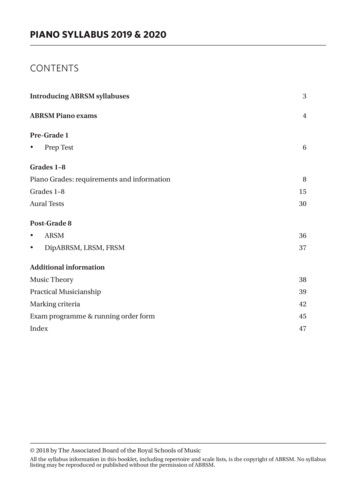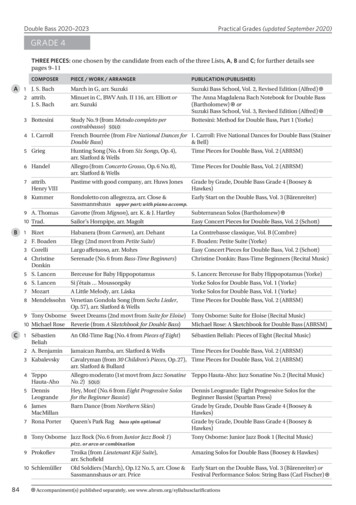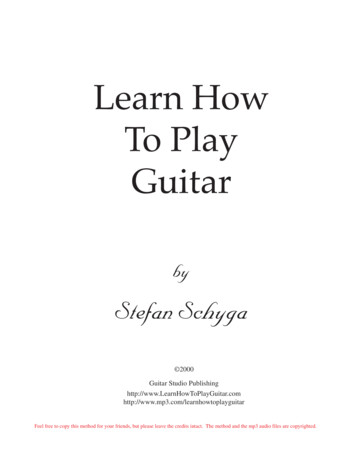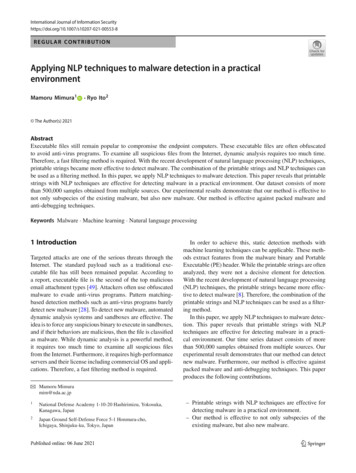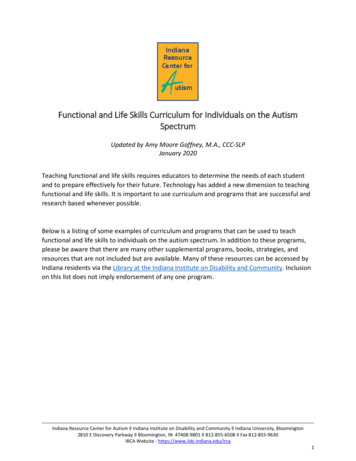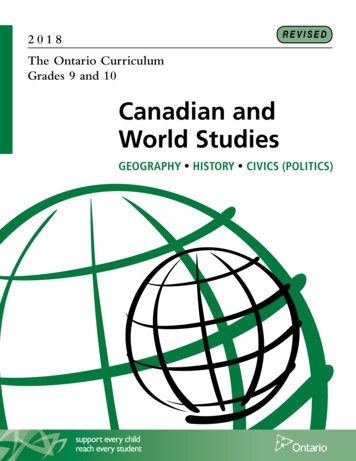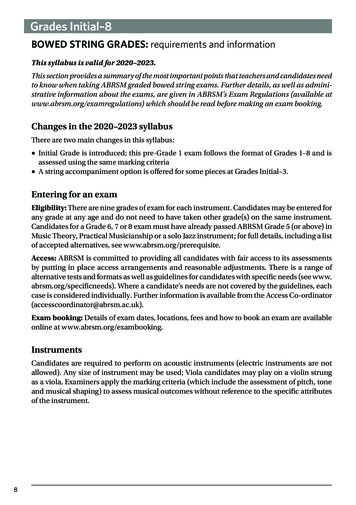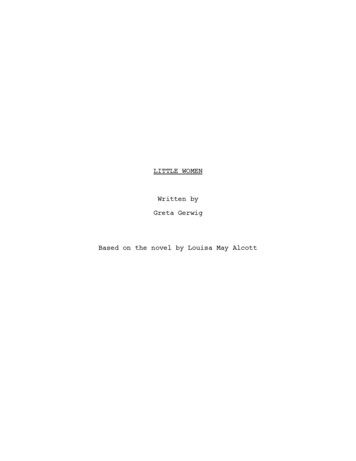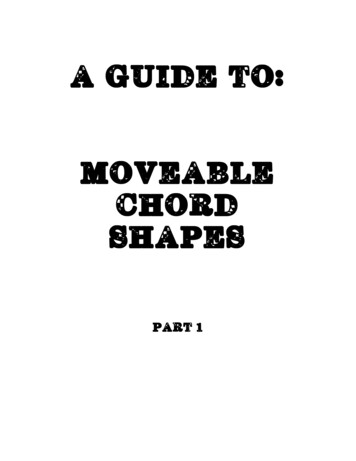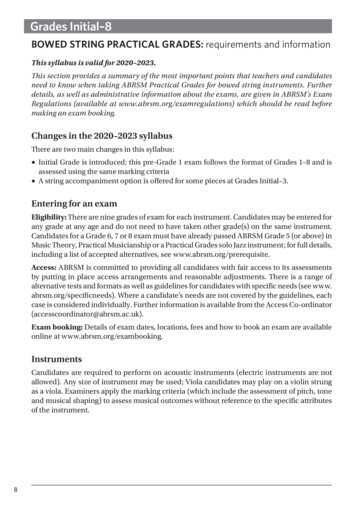
Transcription
Grades Initial–8BOWED STRING PRACTICAL GRADES: requirements and informationThis syllabus is valid for 2020–2023.This section provides a summary of the most important points that teachers and candidatesneed to know when taking ABRSM Practical Grades for bowed string instruments. Furtherdetails, as well as admini strative information about the exams, are given in ABRSM’s ExamRegulations (available at www.abrsm.org/examregulations) which should be read beforemaking an exam booking.Changes in the 2020–2023 syllabusThere are two main changes in this syllabus: Initial Grade is introduced; this pre-Grade 1 exam follows the format of Grades 1–8 and isassessed using the same marking criteriaA string accompaniment option is offered for some pieces at Grades Initial–3.Entering for an examEligibility: There are nine grades of exam for each instrument. Candidates may be entered forany grade at any age and do not need to have taken other grade(s) on the same instrument.Candidates for a Grade 6, 7 or 8 exam must have already passed ABRSM Grade 5 (or above) inMusic Theory, Practical Musicianship or a Practical Grades solo Jazz instrument; for full details,including a list of accepted alternatives, see www.abrsm.org/prerequisite.Access: ABRSM is committed to providing all candidates with fair access to its assessmentsby putting in place access arrangements and reasonable adjustments. There is a range ofalternative tests and formats as well as guidelines for candidates with specific needs (see www.abrsm.org/specificneeds). Where a candidate’s needs are not covered by the guidelines, eachcase is considered individually. Further information is available from the Access Co-ordinator(accesscoordinator@abrsm.ac.uk).Exam booking: Details of exam dates, locations, fees and how to book an exam are availableonline at www.abrsm.org/exambooking.InstrumentsCandidates are required to perform on acoustic instruments (electric instruments are notallowed). Any size of instrument may be used; Viola candidates may play on a violin strungas a viola. Examiners apply the marking criteria (which include the assessment of pitch, toneand musical shaping) to assess musical outcomes without reference to the specific attributesof the instrument.8
Bowed String Practical Grades: requirements and informationElements of the examAll ABRSM Practical bowed string exams consist of: three Pieces; Scales and arpeggios; Sightreading; and Aural tests. In all grades, marks are allocated as follows:Pieces: 123Scales and arpeggiosSight-readingAural testsTotal303030212118150Marking scheme: Exams are marked out of 150. 100 marks are required for a Pass, 120 for aMerit and 130 for a Distinction. Candidates do not need to pass each section to pass overall.See pp. 106–107 for the marking criteria used by examiners.PiecesMusicians learn to play an instrument to explore and perform repertoire, which is why piecesare at the core of the exam – candidates are asked to present three at each grade. The syllabusrepertoire is organised into three lists which explore different traditions and styles, datingfrom the Renaissance period to the present day.Choosing one piece from each list gives candidates the opportunity to play a balancedselection and demonstrate a range of skills. In this syllabus, the pieces are broadly groupedinto lists by the characteristics of the music: List A pieces are generally faster moving and require technical agilityList B pieces are more lyrical and invite expressive playingList C pieces reflect a wide variety of musical traditions, styles and characters.Most of the pieces require an accompaniment, as interacting with other musicians is animportant musical skill, but there are also opportunities to choose solo pieces and developconfidence with unaccompanied playing.We hope that by offering this variety in the syllabus, candidates will find music that inspiresthem and that they enjoy learning and performing.Programme planning: Candidates must choose one piece from each of the three lists (A, Band C)*. In the exam, candidates should tell the examiner which pieces they are performing,and they are welcome to use the form on p. 108 for this.Every effort has been made to feature a broad range of repertoire to suit and appeal tocandidates of different ages, backgrounds and interests. Certain pieces may not be suitable forevery candidate for technical reasons or because of wider context (historical, cultural, subjectmatter of the larger work from which it is drawn, lyrics if an arrangement of a song etc.). Piecesshould be carefully considered for their appropriateness to each individual, which may needconsultation between teachers and parents/guardians. Teachers and parents/guardians shouldalso exercise caution when allowing younger candidates to research pieces online: www.nspcc.org.uk/onlinesafety.* Grade 8 Violin candidates must choose at least one accompanied piece (there are solo pieces on all three lists).9
Bowed String Practical Grades: requirements and informationThe repertoire lists are the same as for ABRSM Performance Grades. Candidates may not presentthe same repertoire (in full or individual pieces) for the same grade of both qualifications,irrespective of when the exams are taken.Accompaniment: A live piano or string (where the option is listed) accompaniment is requiredfor all pieces, except those which are published as studies or unaccompanied works (these aremarked SOLO in the syllabus list).At Grades Initial–3, candidates may perform some or all of their pieces with a string accompaniment. Pieces that are published as duets (or with string accompaniment only) are marked DUETin the syllabus list. Pieces that are published with piano and string accompaniment options aremarked PF/VN , PF/VA , PF/VC , or PF/DB in the syllabus list, and may be performed with eitheraccompaniment in the exam.Candidates must provide their own accompanist(s), who can only be in the exam room whileaccompanying. The candidate’s teacher may accompany (examiners will not). If necessary,an accompanist may simplify any part of the accompaniment, as long as the result is musical.Recorded accompaniments are not allowed.Exam music & editions: Wherever the syllabus includes an arrangement or transcription(appearing as ‘arr.’ or ‘trans.’ in the syllabus list), the edition listed in the syllabus must be usedin the exam. For all other pieces, editions are listed for guidance only and candidates may useany edition of their choice (in- or out-of-print or downloadable). Information on sourcing exammusic is given on p. 13.Interpreting the score: Printed editorial suggestions such as fingering, bowing, metronomemarks, realisation of ornaments etc. do not need to be strictly observed. Whether the piececontains musical indications or not, candidates are encouraged to interpret the score in amusical and stylistic way. Examiners’ marking will be determined by how control of pitch, time,tone, shape and performance contributes to the overall musical outcome.Vibrato: The use and control of vibrato, and its effect on tone and shape, will be taken intoaccount by examiners, who will be assessing the overall musical outcome. Pieces that areheavily reliant on vibrato for their full musical effect tend not to appear in the syllabus beforearound Grade 5.Repeats: Unless the syllabus specifies differently, all da capo and dal segno indications shouldbe followed but other repeats (including first-time bars) should not be played unless they arevery short (i.e. a few bars).Cadenzas & tuttis: Cadenzas should not be played unless the syllabus specifies differently.Accompanists should cut lengthy orchestral tutti sections.Performing from memory: Candidates may perform any of their pieces from memory; if doingso, they must make sure that a copy of the music is available for the examiner to refer to. Noextra marks are awarded for playing from memory.Page-turns: Examiners will be understanding if a page-turn causes a lack of continuity during apiece, and this will not affect the marking. Candidates (and accompanists) may use an extra copyof the music or a photocopy of a section of the piece (but see ‘Photocopies’ on p. 11) to help withpage-turns. Candidates and accompanists at Grades 6–8 may bring a page-turner to the examif there is no solution to a particularly awkward page-turn (prior permission is not required;the turner may be the candidate’s teacher). Examiners are unable to help with page-turning.10
Bowed String Practical Grades: requirements and informationPhotocopies: Performing from unauthorised photocopies (or other kinds of copies) or illegaldownloads of copyright editions is not allowed. ABRSM may withhold the exam result where ithas evidence of an illegal copy (or copies) being used. In the UK, copies may be used in certainlimited circumstances – for full details, see the MPA’s Code of Fair Practice at www.mpaonline.org.uk. In all other cases, application should be made to the copyright holder before any copyis made, and evidence of permission should be brought to the exam.Scales and arpeggiosPlaying scales and arpeggios is important for building strong technical skills such as reliablefinger movement, hand position, co-ordination and fingerboard fluency. It also helps todevelop tone, pitch and interval awareness, and familiarity with keys and their relatedpatterns. This leads to greater confidence and security when sight-reading, learning newpieces and performing – from a score or from memory, as a solo musician or with others.Memory: All requirements should be played from memory.Range: All requirements should be played from the lowest possible tonic/starting note unlessthe syllabus specifies differently. They should ascend and descend according to the specifiedrange (and pattern).Rhythm: For most major and minor scales (and double-stop scales in parallel sixths/octaves)candidates may choose between two rhythm patterns: even notes or long tonic. The scale to afifth (Initial Grade) should be played in even notes.Patterns: Arpeggios and dominant sevenths are required in root position only. All dominantsevenths should finish by resolving on the tonic. Examples of scale/arpeggio etc. patternsfound in this syllabus are given on pp. 14–15. Fully notated versions of the requirements arepublished by ABRSM.Fingering: Candidates may use any fingering that produces a successful musical outcome.Speed: Bowing will generally dictate the tempi of slurred scales and arpeggios. Separatelybowed requirements should be played briskly, using no more than half the bow length. Thespeeds on pp. 16–19 are given as a general guide.In the exam: Initial Grade candidates should play all three requirements when asked for theirscales. The examiner will prompt the keys/ranges where necessary.At Grades 1–8, examiners will usually ask for at least one of each scale/arpeggio (etc.) type.They will ask for majors followed by minors within each type, and also ask to hear a balanceof the separately-bowed and slurred requirements. When asking for requirements, examinerswill specify: the key* (including minor form – harmonic or melodic – in the Grade 6–8 scales) or thestarting noteseparate bows or slurred (except for where the requirements are to be prepared with separatebows only – e.g. Grade 1 arpeggios).* Where keys at Grades 6–8 are listed enharmonically – D - /C and A - /G – the examiner willuse the flat spelling when asking for major keys and the sharp spelling for minor keys.11
Bowed String Practical Grades: requirements and informationSight-readingSight-reading is a valuable skill with many benefits. Learning to sight-read helps to developquick recognition of keys, tonality and common rhythm patterns. Strong sight-reading skillsmake learning new pieces quicker and easier, and also help when making music with others,so that playing in an ensemble becomes more rewarding and enjoyable.Candidates will be asked to play a short unaccompanied piece of music which they have notseen before. They will be given half a minute to look through and, if they wish, try out all or anypart of the test before they are asked to play it for assessment. The tables on pp. 20–21 show theelements that are introduced at each grade.For practice purposes, sample sight-reading tests are published by ABRSM.Aural testsListening lies at the heart of music-making and the ability to hear how music works helps withall aspects of musical development. Aural skills help with gauging the sound and balance ofplaying, keeping in time and playing with a sense of rhythm and pulse. These skills also helpto develop a sense of pitch, musical memory and the ability to spot mistakes.The requirements are the same for all four instruments. Full details of the Aural tests are givenon pp. 94–101.In the examExaminers: Generally, there will be one examiner in the exam room; however a secondexaminer may be present for training and quality assurance purposes. Examiners may ask tolook at the candidate’s or accompanist’s copy of the music before or after the performance of apiece; a separate copy is not required. Examiners may stop the performance of a piece when theyhave heard enough to make a judgment. They will not issue or discuss a candidate’s result; themark form (and certificate for successful candidates) will be issued by ABRSM after the exam.Order of the exam: The individual sections of the exam may be taken in any order, at thecandidate’s choice, although it is preferable for accompanied pieces to be performedconsecutively at the beginning of the exam.Tuning: At Grades Initial–5, the teacher or accompanist may tune the candidate’s instrument(or advise on tuning) before the exam begins. At Grades 6–8, candidates must tune theirinstruments themselves. Examiners are unable to help with tuning.Seating: Double Bass candidates should provide their own stool if required. A chair/stool willbe provided for cello candidates at ABRSM public venues.Music stands: All ABRSM public venues provide a music stand, but candidates are welcome tobring their own if they prefer. The examiner will be happy to help adjust the height or positionof the stand.12
Bowed String Practical Grades: requirements and informationAssessmentThe tables on pp. 106–107 show the marking criteria used by examiners. Examiners mark up ordown from the pass mark for each element by balancing the extent to which the qualities andskills listed on pp. 106–107 (broadly categorised by pitch, time, tone, shape and performance)are demonstrated and contribute towards the overall musical outcome.Sourcing exam musicExam music is available from music retailers and online, including at the ABRSM music shop:www.abrsm.org/shop. Every effort has been made to make sure that the publications listed willbe available for the duration of the syllabus. Candidates are advised to get their music well beforethe exam in case items are not kept in stock by retailers. Non-exam related questions about themusic (e.g. editorial, availability) should be addressed to the relevant publisher: contact detailsare listed at www.abrsm.org/publishers.13
SCALE AND ARPEGGIO PATTERNSThe examples below clarify patterns found in this syllabus. The full requirements for eachinstrument and grade are listed on the relevant syllabus pages. See also p. 11.RHYTHM PATTERNS FOR SCALESFor major scales (all grades) and minor scales (Grades 1–8), candidates may choose betweentwo rhythm patterns: even notes or long tonic. (Chromatic scales should always be playedwith even notes.)even noteslong tonicorœ44œœœœœœœœ44 œ œ œ œ œ œ œ œ etc.etc.SLURRING PATTERNS FOR SCALESeven notes2 quavers:2 beats:7 notes:long tonicor44œ œ œ œ œ œ œ œ œetc.78œœœœœœœ œetc.44œ œ œ œ œ œ œ œetc.NATURAL MINOR SCALEV#ww w w w w w w w w w w w w wAwwwwwwwwwwwwwwwBwwwwwwwwwwwwwwwSCALE to a fifthDOMINANT SEVENTH (resolving on tonic)V # 42 œœ œ œœ œ œ œV 42 œŒœœ œ œœ œ œœDOUBLE-STOP SCALESIn broken stepsin sixths:in octaves:in thirds:14V bb 44 œ œ ‰‰V ## 44 œ œ ‰‰V bb 44 œ œ ‰‰‰œ ‰œ ‰œœ œ‰‰‰œ ‰œ ‰œ œ ‰œetc. œetc. etc. œ‰‰œ ‰œ ‰œ œ ‰œœetc. etc. etc. œŒ
Scale and arpeggio patternsDOUBLE-STOP SCALES (cont.)In paralleleven notesin sixths:in octaves:orV bbb 44 œœ œœV ## 44 œ œœœetc.œ œ œœœ œœ œ œœ œ œetc.long tonicV bbb44 œœV ## 44 œœœœ œ œœ œœ œœ œœœœœetc.œœ œ œ œ œœ œœœœ œœœetc.Patterns for Double Bass onlySCALES to a sixtheven notesB 42 œ œ œ œorœ œ œ œ œ œ œlong tonicB 43 œœœœœ œ œœœœ œ Œ ŒSCALES to a twelftheven notesBborœœœœœ44œ œ œ œ œ œ œ œetc.long tonicB b 44 œ œ œ œ œ œ œ œ œ œ œ œ œ œ œ œ œ œ œ œ œ œ œ Œ ÓARPEGGIOS to a twelfthB b 68 œ œ œ œ œ œœœœœ œ œ œ Œ SCALE IN BROKEN THIRDSB# 44 œ œ œ œ œ œ œ œ œœœœœœœœœ œœœœœetc.etc.œœœœ œœœœÓSCALE IN RUNNING THIRDSB# 68 œ œ œ œ œ œœetc.Vœœœ œœœœœœ œetc.Bœ œ œœ œ œ œ 15
16* Dim. 7ths from Grade 5q iq iiiqiiiq orq q hDouble-stop scales(in broken steps)Double-stop scales(in parallel)iiiqjjjjjqiiiq / iiq /iiqq iq iiiqiiiq orpatternDom. & Dim. 7ths *Chromatic scalesArpeggiosScalesVIOLINq 46InitialThe following speeds are given as a general guide:e 104q 521e 116q 582q 63q . 40q 633q 63q 69q . 42q 694Grade/Speedq 66q 80q . 44q 805q 92q 69q . 60q . 46q 926q 104q 72e 104q . 48q 1047q 72q 120q 76e 120q . 50q 1208SCALE AND ARPEGGIO SPEEDS
SIGHT-READING PARAMETERSThe tables on pp. 20–21 show the elements that are introduced at each grade. These parametersare presented cumulatively, i.e. once introduced they apply for all later grades (graduallyprogressing in difficulty). See also p. 12.Length(bars)TimeOther features that may be included44 462 4Grade 143 4Grade 28 Initial GradeGrade 3Grade 420c. 86 8Grade 5c. 8–16Grade 6c. 12–169 85 85 4Grade 7c. 16–207 87 4Grade 8c. 16–2412 8 1st positionq and iq note values; Î restsnotes separately bowedmfh and iiiq note valuesf and pDouble Bass: 1st or half position, at candidate’s choice h . ; restssimple two-note slursmp ; cresc. and dim. hairpinsDouble Bass: 1st position onlyaccidentals (within minor keys)q . e and q a . a i ; simple semiquaver patterns; ä reststied notesstaccato; pizzicato (at end)Double Bass: half or 1st position, at examiner’s choiceshifts between: Violin & Viola: 1st and 3rd positions Cello: 1st and 4th positions Double Bass: half, 1st and 3rd positions (no more than twopositions per test)chromatic notesanacrusishooked bowingtenuto, accentspause signpp and ffshifts as required to cover rangesimple syncopationchanges between arco and pizzicatoslowing of tempo (at end)Violin, Viola & Cello: simple chords (at end)triplet patternsslowing of tempo followed by a tempoViola: treble clefDouble Bass: simple chords (at end)Violin & Viola: left-hand pizzicatoCello & Double Bass: tenor clefacceleration of temposimple ornamentsViolin: 8va signCello: left-hand pizzicatoCello & Double Bass: treble clef
Sight-reading parametersKEYSMAJORSminors *ViolinViolaCelloDouble Bass Initial GradeD, AG, DG, DG, D———Grade 2GeCaCaC, G, DaGrade 3C, F, B a, d, gF, B -, E d, g, cA, F, B d, gF, B bGrade 4E-AEcAe, dGrade 5E, A b, cE, A e, f egc f—Ecf b, c E, A b, fEf B, D fB, D f AfRANGES §ViolinViolaCelloDouble BassInitial Graded′–g′, a′–d″g–c′, d′–g′G–c, d–gg–b, d–f Grade 1d′–a″g–d″G–d′d–b or F–f Grade 2g–a″c–d″C–d′E–bGrade 3g–b″c–e″C–d′E–bGrade 4g–d‴c–g″C–g′E–d′Grade 5g–e‴c–a″C–a′E–e′Grade 6g–e‴c–a″C–a′E–g′Grade 7g–g‴c–b″C–b - ′E–a′Grade 8g–a‴c–c‴C–d″E–c″Grade 1Grade 6Grade 7Grade 8* §G, D or F, B - Minors – natural form at Grade 2, any form from Grade 3Keys cumulative from Grade 21st or half position, at candidate’s choiceRanges are presented using the Helmholtz system, i.e.:?w wB′Cw wBcwb&wc′w wb′w wc″ b″wc‴ b‴21
Violin Practical Grades (updated2020–2023September 2020)Violin 2020–2023 INITIAL GRADETHREE PIECES: one chosen by the candidate from each of the three Lists, A , B and C; for further details seepages 9–11A12345COMPOSERPIECE / WORK / ARRANGERPUBLICATION (PUBLISHER)Sheila NelsonTrad.AmericanTrad. GermanKatherine &Hugh ColledgeCutterFish Cakes and Apple PieOld-Timer, arr. Huws Jones with repeatViolin Exam Pack 2020–2023, Initial Grade (ABRSM)Violin Exam Pack 2020–2023, Initial Grade (ABRSM)Lightly Row, arr. BlackwellKnickerbocker Glory (No. 10 from WaggonWheels)Little March, arr. K. & C. SassmannshausViolin Exam Pack 2020–2023, Initial Grade (ABRSM)Katherine & Hugh Colledge: Waggon Wheels for Violin(Boosey & Hawkes)Violin Recital Album, Vol. 1 (Bärenreiter)ending at b. 20 PF/VN6 StanleyFletcherSweet Eyed Sue (No. 9 from New Tunes forStrings, Book 1) with repeat using bowingStanley Fletcher: New Tunes for Strings, Violin Book 1(Boosey & Hawkes)variation 1 PF/VN7 Trad.Big Ben, arr. Davey, Hussey & SebbaAbracadabra Violin (Third Edition) (Collins Music)upper part PF/VN8 Trad.Secret Agents, arr. Davey, Hussey & SebbaAbracadabra Violin (Third Edition) (Collins Music)upper part; with repeat PF/VN9 Trad.B10 WohlfartGo Tell Aunt Rhody, arr. SuzukiPolka, arr. Nelson1Waterfall (No. 9 from Waggon Wheels)Violin Exam Pack 2020–2023, Initial Grade (ABRSM)Silent FriendsViolin Exam Pack 2020–2023, Initial Grade (ABRSM)On the RiverViolin Exam Pack 2020–2023, Initial Grade (ABRSM)23456Katherine &Hugh ColledgeThomasGregoryEdward HuwsJonesKathy & DavidBlackwellTrad.AmericanThomasGregoryEdward HuwsJonesSheila NelsonChinese GardenSuzuki Violin School, Vol. 1 (Alfred)Piece by Piece 1 for Violin (Boosey & Hawkes)PF/VNFiddle Time Joggers (OUP)PF/VNThe Mocking Bird, arr. K. & D. BlackwellPF/VNFootprints in the SnowVamoosh Violin, Book 1 (Vamoosh)Gone for Good (No. 12 from Ten O’Clock Rock)10 Sheila Nelson Swingalong ‘E' version PF/VNEdward Huws Jones: Ten O’Clock Rock for Violin(Boosey & Hawkes)The Essential String Method, Violin Book 2 (Boosey &Hawkes)Piece by Piece 1 for Violin (Boosey & Hawkes)P. 16 from Tetratunes for Violin (Boosey & Hawkes)1In the GrooveViolin Exam Pack 2020–2023, Initial Grade (ABRSM)Hop Scotch (No. 2 from Child’s Play)Hill and gully rider, arr. BullardViolin Exam Pack 2020–2023, Initial Grade (ABRSM)Violin Exam Pack 2020–2023, Initial Grade (ABRSM)Rhythm FeverFiddle Time Joggers (OUP)78I am a River9 Sheila Nelson Over the MoonC23456722Fiddle Time Joggers (OUP)Kathy & DavidBlackwellPeter MartinTrad.JamaicanKathy & DavidBlackwellThomasGregoryAnitaHewitt-Jones& CarolineLumsdenEdward HuwsJonesPF/VNWalk on Mars! slides optional; with DC, as inVamoosh Violin, Book 1 (Vamoosh)accomp.Have a Cup of Tea (from Bread and ButterPudding)Lumsden & Hewitt-Jones: Bread and Butter Pudding(Musicland)Ten O’Clock Rock (No. 9 from Ten O’ClockRock)Edward Huws Jones: Ten O’Clock Rock for Violin(Boosey & Hawkes)Accompaniment(s) published separately, see www.abrsm.org/syllabusclarifications
Practical Grades (updated September 2020) COMPOSER8 CarolineViolin 2020–2023 Initial GradePIECE / WORK / ARRANGERPUBLICATION (PUBLISHER)Jungle Footprints (from Jackaroo)Lumsden & Wedgwood: Jackaroo for Violin (Faber)Lumsdenscream optional& PamWedgwood9 Trad. German Pit a Pat Rain, arr. K. & C. SassmannshausViolin Recital Album, Vol. 1 (Bärenreiter)PF/VN10 Peter WilsonBow Rock (No. 4 from Stringpops 1)Wilson & Ranger: Stringpops 1 for Violin (Faber)SCALES: from memory; for further details (including examples) see pages 11, 14–15 & 16 RANGEREQUIREMENTSD, A majors starting on open strings1 oct.E minor starting on bottom Ea 5thseparate bows;even notes or long tonic, at candidate’s choiceseparate bows;even notesSCALESSIGHT-READING: a short piece of previously unseen music; for further details see pages 12 & 20–21AURAL TESTS: administered by the examiner from the piano; for further details see pages 94 & 9523
Violin 2020–2023 Practical Grades (updated September 2020)GRADE 1THREE PIECES: one chosen by the candidate from each of the three Lists, A , B and C; for further details seepages 9–11COMPOSERA1PUBLICATION (PUBLISHER)Violin Exam Pieces 2020–2023, Grade 1 (ABRSM)10German Dance (No. 8 from 12 German Dances,Hob. IX:10), arr. SalterTrad. WelshY Delyn Newydd, arr. BlackwellPeter Martin Hornpipe (No. 2 from Little Suite No. 3)ArbeauMattachins, arr. Huws JonesKathy & David Patrick’s Reel PF/VNBlackwellCarseMinuet (from The Fiddler’s Nursery)ThomasSinfonia PF/VNGregoryPurcellRigadoon, arr. Nelson with repeatSuzukiAndantino PF/VNTrad. IrishJohn Ryan’s Polka, arr. Huws Jones PF/VN1BartókRound Dance (No. 17 from For Children, Vol. 1),arr. DaviesBeethovenOde to Joy (from Symphony No. 9, Op. 125,4th movt), arr. Scott-BurtTrad. Scottish Skye Boat Song, arr. GrittonKathy & David Rocking Horse PF/VNBlackwellKatherine &Full Moon (No. 22 from Waggon Wheels)Hugh ColledgeLehárWaltz (from The Merry Widow), arr. Huws JonesViolin Exam Pieces 2020–2023, Grade 1 (ABRSM)23456789BPIECE / WORK / ARRANGER23456Haydn7 Rodgers &Edelweiss (from The Sound of Music),Hammerstein arr. Davey, Hussey & Sebba PF/VN8 SchubertCradle Song, arr. Nelson upper part DUET9 Trad.The Leaving of Liverpool, arr. Huws JonesViolin Exam Pieces 2020–2023, Grade 1 (ABRSM)Violin Exam Pieces 2020–2023, Grade 1 (ABRSM)Encore Violin, Book 1 (ABRSM)Fiddle Time Joggers (OUP)Carse: The Fiddler’s Nursery for Violin (Stainer & Bell)Vamoosh Violin, Book 1.5 (Vamoosh)Piece by Piece 1 for Violin (Boosey & Hawkes)Suzuki Violin School, Vol. 1 (Alfred)Violin Star 2 (ABRSM)Violin Exam Pieces 2020–2023, Grade 1 (ABRSM)Violin Exam Pieces 2020–2023, Grade 1 (ABRSM)Fiddle Time Joggers (OUP)Katherine & Hugh Colledge: Waggon Wheels for Violin(Boosey & Hawkes)Going Solo for Violin (Faber) orThe Best of Grade 1 Violin (Faber)Abracadabra Violin (Third Edition) (Collins Music)Tunes You Know 1 for Violin Duet (Boosey & Hawkes)The Seafaring Fiddler (Boosey & Hawkes)violin melody PF/VN10 Trad. EnglishC1PF/VNTango (No. 2 from Four Modern Dance Tunes)What shall we do with the drunken sailor?,arr. BullardR. & R.Chitty Chitty Bang Bang (from Chitty ChittyShermanBang Bang), arr. IlesKlaus Badelt & He’s a Pirate (from Pirates of the Caribbean:Hans Zimmer The Curse of the Black Pearl), arr. Galliford &Neuburg with repeat; ending 1st beat of b. 22ThomasFiery Fiddler with repeatsGregoryEdward Huws SharksJonesTrad.Pick a Bale of Cotton, arr. K. & D. BlackwellPF/VNAmericanTrad.Turkey in the Straw, arr. Cohen & SpearingAmericanswung rhythm optionalTrad. Chinese Jasmine Flower (No. 4), arr. O’Leary SOLOTrad. CzechRocking, arr. Nelson upper part DUETViolin Star 2 (ABRSM)Violin Exam Pieces 2020–2023, Grade 1 (ABRSM)Violin Exam Pieces 2020–2023, Grade 1 (ABRSM)3Violin Exam Pieces 2020–2023, Grade 1 (ABRSM)4567891024A North Country Lass, arr. Huws JonesN. Mackay2 Trad.Top Hits from TV, Movies & Musicals for Violin(Alfred)Vamoosh Violin, Book 1 (Vamoosh)Going Solo for Violin (Faber) orThe Best of Grade 1 Violin (Faber)Fiddle Time Runners (OUP)Superstart Violin (Faber)No. 4 from 80 Graded Studies for Violin, Book 1 (Faber)Tunes You Know 1 for Violin Duet (Boosey & Hawkes)Accompaniment(s) published separately, see www.abrsm.org/syllabusclarificationsAccompaniment printable from companion CD
Practical Grades (updated September 2020) Violin 2020–2023 Grade 1SCALES AND ARPEGGIOS: from memory; for further details (including examples) see pages 11, 14–15 & 16 RANGEREQUIREMENTS1 oct.separate bows or slurred (2 quavers to a bow), atexaminer’s choice;even notes or long tonic, at candidate’s choiceSCALESD, A majors starting on open stringsE natural minorG major2 oct.ARPEGGIOSD, A majors starting on open stringsE minorG major1 oct.2 oct.separate bows;even notesSIGHT-READING: a short piece of previously unseen music; for further details see pages 12 & 20–21AURAL TESTS: administered by the examiner from the piano; for further details see pages 94 & 9525
Violin 2020–2023 Practical Grades (updated September 2020)GRADE 2THREE PIECES: one chosen by the candidate from each of the three Lists, A , B and C; for further details seepages 9–11ACOMPOSERPIECE / WORK / ARRANGERPUBLICATION (PUBLISHER)MozartViolin Exam Pieces 2020–2023, Grade 2 (ABRSM)8 G. B. MartiniAllegretto (from Clarinet Quintet, K. 581,4th movt), arr. Scott-BurtMenuet in G, BWV Anh. II 114, arr. Huws JonesMinuett (No. 7 from The Double Dealer, Z. 592),arr. BlackwellMusette, arr. SuzukiRigaudon, arr. Mohrs upper part DUETAir, arr. Mohrs trill optionalMinuet and Trio, arr. Nelson without DCGavotte, arr. de Keyser & Waterman9 Trad. IrishRed-Haired Boy, arr. Huws Jones12 C. Petzold3 Purcell4 J. S. Bach10 Trad. Scottish Soldier’s Joy, arr. Nelson upper part DUETSuzuki Violin School, Vol. 2 (Alfred)Duets for Fun: Violins (Schott)My First Concert for Violin (Schott)Piece by Piece 1 for Violin (Boosey & Hawkes)The Best of Grade 2 Violin (Faber) orThe Young Violinist’s Repertoire, Book 1 (Faber)The Fiddler Playalong Violin Collection 2(Boosey & Hawkes) orJigs, Reels & Hornpipe (Boosey & Hawkes)Tunes You Know 2 for Violin Duet (Boosey & Hawkes)1Violin Exam Pieces 2020–2023, Grade 2 (ABRSM)5 Boismortier6 Finger7 Haydnviolin melody PF/VNBViolin Exam Pieces 2020–2023, Grade 2 (ABRSM)Violin Exam Pieces 2020–2023, Grade 2 (ABRSM)2345Theme (from Symphony No. 1, 3rd movt),arr. GrittonTrad. Chinese Bamboo in the Breeze, arr. Huws JonesSchönberg,Castle on a Cloud (from Les Misérables),Boublil, Natel arr. Bullard& KretzmerKatherine &Weeping Willow (No. 10 from Fast Forward)Hugh ColledgeEdward Jones Glwysen, arr. Huws Jones violin melody PF/VNMahler6 MozartTheme (from Sonata in A, K. 331, 1st movt),arr. Gazda & Clark upper part; grace notesViolin Exam Pieces 2020–2023, Grade 2 (ABRSM)Violin Exam Pieces 2020–2023, Grade 2 (ABRSM)Katherine & Hugh Colledge: Fast Forward for Violin(Boosey & Hawkes)The Fiddler Playalong Violin Collection 2(Boosey & Hawkes) orThe Celtic Fiddler (Boosey & Hawkes)Compatible Duets for Strings, Vol. 2: Violin(Carl Fischer)optional DUET7 OffenbachC8 TchaikovskyBarcarolle (from The Tales of Hoffmann),arr. Gregory with repeatsWaltz (from The Sleeping Beauty), arr. Cohen9 Trad. NorthSimple Gifts, arr. Waterfield & BeachAmerican10 Trad.Greensleeves, ar
This syllabus is valid for 2020–2023. . Viola candidates may play on a violin strung as a viola. Examiners apply the marking criteria (which include the assessment of pitch, tone and musical shaping) to assess musi
